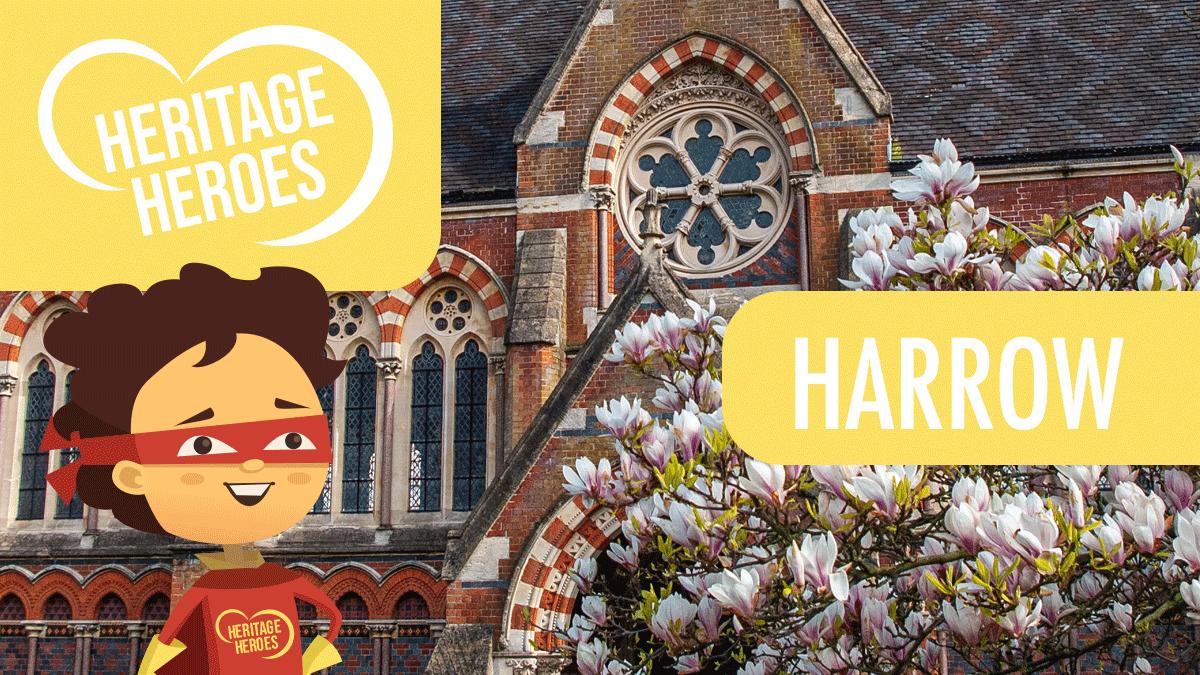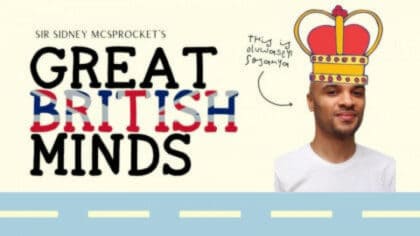Wherever you live, there’s treasure to be discovered! Not just gold and gems, but stories of buildings, locations and people.
Our heritage is a great wealth… and it’s all around us.
Sometimes standing proud in the open air, sometimes hidden behind some bushes.
To help find it, we asked for your help and to become Heritage Heroes.

HERITAGE HEROES. AN INSPIRING AUDIO PRODUCTION FOR FUN KIDS. MADE POSSIBLE WITH THE NATIONAL LOTTERY HERITAGE FUND, WITH THANKS TO NATIONAL LOTTERY PLAYERS.
Harrow is in north west London and along with nearby Pinner, is a bustling hub that’s always been a popular place to live. It’s especially popular with people who work in central London.
In fact, in the 1950s Harrow was known as the “capital city of Metroland”.

History of Harrow
Way back in time, Harrow was a sleepy hamlet with just a handful of houses on the hill.
Its name comes from Old English ‘hearg’ which means heathen temple, which was probably on Harrow Hill where St. Mary’s Church stands today.

Whilst the top of the 124 metre hill has been the historic centre of Harrow for centuries, the modern town of Harrow grew at the foot of the hill in what was historically called Greenhill.
Harrow is known for being a metropolitan town (that’s one which is densely populated) but it also has some amazing areas of natural beauty.
In Stanmore, two ponds known formally as the Spring Ponds have another name, ‘Caesar’s Ponds’. They’re a series of manmade ponds from Roman times which, according to mythology, were visited by the ancient British Queen Boudicca, who in the year 60 AD led a revolt against Roman rule..

In medieval times, Pinner would have been a small rural settlement surrounded by agricultural land. Villagers would have cultivated crops such as wheat, barley and vegetables, whilst raising livestock like sheep and cattle for wool and meat.
Like many villages at this time, Pinner would have been organised around a manor system, with a lord overseeing the local land and its inhabitants. The lord would have had authority over the villagers, providing protection and enforcing rules.
As well as farming, villagers might have engaged in cottage industries such as weaving, pottery and blacksmithing, which they would have carried out within their homes or small workshops.
Embed from Getty ImagesThings really began to change for the area when Harrow became a bustling commuter town, with an explosion of new industry during the Victorian railway boom.
Harrow and Wealdstone Station
The station opened in 1837 making it one of the oldest in the country. It’s amazing to think that when it opened the surrounding area was just fields and countryside, but within a century it changed beyond recognition.

Just outside the station is a memorial garden. There are memorials for all sorts of things in our towns and villages and they can tell us about important people or events that happened in the area.
You told us…
- “In 1952 there was a really bad accident when several trains collided – there were three passenger trains and one freight train. 112 people died and lots of people were injured. So the memorial is for remembering those people.“
The Railway and Metroland
As well as Harrow and Wealdstone station, Harrow has a couple of others, including South Harrow.

This station was built in 1903 as part of the extension of the District Line, before becoming part of the Piccadilly Line in 1933.
The railway companies extended the lines to serve London’s growing population and followed where developers were building new housing estates, coining the phrase ‘Metroland’.

Many of these new estates were built with a new style of housing, the three-bed semi-detached home, built mainly for the new lower middle class.
Ironically, the marketing used to sell these homes focused on the romantic idea of the countryside that the developments were swallowing up.
Green space, fresh air and historic villages such as Pinner, Stanmore and Ruislip were all given as inducements to leave the city centre and use the new commuter services to get the best of both worlds.
The slogan “Live in Metro-land” was even etched on the door handles of Metropolitan carriages to entice passengers using the service.

Headstone Museum
If you want to get a glimpse of what life might have looked like before the Victorian times and the advent of the railways, what better place to start than at the Headstone Museum.
The museum is housed at the historic Headstone Manor, a place packed with its own history.

Here’s something you said…
- “The manor is over 700 years old and the small barn was built in the Tudor period. It was also used to house livestock. The great barn was built in 1506 by the Archbishop of Canterbury. In some time during the 17th or 18th century the building was converted to a farmhouse and in 1631 it was bought by Francis Reuss who built a rare extension to the Great Hall. I like the inside of the house. It’s really old and it shows you a lot of things in it.“
The Manor House with its moat and accompanying buildings has witnessed centuries of history and the original medieval structure is complemented by the Tudor, Georgian and Victorian additions over the years although its history stretches even further back than that.
What you said…
- “Objects dating back to the Stone Age have been found at Headstone Manor. You can see a magnificent hand axe in the small barn. The name Headstone sounds spooky, but actually comes from the Saxon word ‘Hecton’. It means a farm with hedges. The first recorded person who lived at Headstone was called Elwyn de la Hegg. His name translated as Mr Hedges. Henry VIII owned the House for a short time, but he wanted the money, so he sold it on to one of his friends.“
- “The Manor House is surrounded by a water filled moat. There aren’t many of these left, so it’s a really special feature. It wasn’t built for defence. We think it was built to show what an important place this is.“
- “The farm at Headstone was around 400 acres, one of the biggest farms near London for most of its history. If you want to learn more about the history of Harrow, this is the place to come and best of all, it’s all free.“

The Manor House is one of the oldest surviving timber framed buildings in Middlesex.
A great thing about exploring your town’s heritage is that whilst museums are amazing places, you can find clues to the past just by looking around where you live, taking notice of the types of buildings, street lighting and other street furniture.
An old telephone box
The phone box was invented by Sir Giles Gilbert Scott in 1935. It’s quite a famous design.
It’s basically a cuboid and there’s a door that you have to pull. You go in, type in the number and then you can call someone with the telephone!

It might be hard to imagine life without a mobile phone but the evidence is there for all to see in these iconic phone boxes.
There might be old phone boxes near you and some might still have a working telephone!
I wonder if you can send emoji’s from them?
Kodak – a factory, chimney and statue…
The Kodak Monument is just a 5 minute walk from Headstone Manor.

Its design is based on the iconic Kodak Hawkeye Instamatic camera. It’s enormous and like most monuments, it’s been built so we remember something important, in this case, Harrow’s Kodak Factory.

Here’s something you told us…
- “I like the Kodak monument as it’s like a massive camera. It’s about 20 feet tall and you can go inside it! There’s a door on the side where you can go in and strike a pose pretending to be in a giant photo.”
When Kodak opened their factory in 1891, Wealdstone was a hamlet of just 200 houses. Within 21 years, there were over 2,500 homes and six factories, plus a thriving high street, places of worship and schools.
Looking after your employees was important to Kodak, and they built many homes for their workers, as well as schools and places of entertainment.
You said…
- “Some people didn’t like to live so close to their boss but Kodak made sports fields and theatres and clubs so lots of people from the same family worked there. There was a hooter that blew in the morning to get everyone to work.”
Even though the factory has gone, along with the monument, you can still see the old 213 foot factory chimney which dominates the skyline. It’s standing out after getting a fresh coat of white paint, with red at its tip.
Here’s something you told us…
- “The Kodak Chimney reminds people of when this was the biggest employer in Harrow. It produced photographic film and paper. It was built here because of the space, fresh air and clean water, as well as access to a nearby railway to transport goods. The factory in Harrow was the largest photographic manufacturing plant in the British Commonwealth at the height of its output in the 1950s. It employed more than 6,000 people, many of the early workers were women. The factory even had a sports ground that workers could play football on.“
Whitefriars Glass
Another industry that Harrow was famous for was glass.
Whitefriars Glass started producing glass in the 17th century in a smoggy corner of the City of London and was famous for its decorative quarry glass which was moulded, printed with black detailing and stained yellow.
As it was a lot cheaper to produce than stained glass, it was often used in Victorian churches.

Whitefriars moved to Tudor Road in Wealdstone in 1923 where it had two furnaces.
A great little story is that on opening, a lit brazier was carried from the old glasshouse to the new factory to light the first furnace, continuing the burning of the flame from the city glasshouse furnaces which had burnt continuously since 1680.
The business sadly has gone, but you can see examples of Whitefriars Glass at Headstone Manor.

The Zoroastrian Centre
When we look at the heritage of a place, it’s important to think about religion and faiths that have been important both in the past and today.
Harrow certainly has a diverse population when it comes to faith, with over 80 places of worship representing religions from Jain to Buddhism.
One of these is Zoroastrianism. Now, you might not have heard of it, but you might know one of its British followers, Freddie Mercury from supergroup Queen. It’s one of the oldest religions in the world, originating in 1,500 BC in ancient Iran.

You told us…
- “The Zoroastrian Centre was built in 1936 by a designer called Frank Ernest Bromige and was originally a cinema. Its style is called Art Deco and it has lots of curved lines. When it opened it could seat 1,000 people.“
It closed as a cinema in 1964 but remains as an important centre of faith.

The Queens Head in Pinner
Like many historic pubs, the Queen’s Head has been a place for locals to socialise and relax for hundreds of years.
It was known as the Crown Inn until 1715 when the name was changed to the Queens Head in commemoration of Queen Anne who used to change horses here when riding between Hatfield and London.

Pubs can have rather strange names but there’s usually a historic reason for them. It might be a person, an event or some old folk tale!
Why not try to find out how the pubs near you got their names?
Elliot Hall – part of Harrow Arts Centre
A trip to the theatre can be fun, and entertainment places like cinemas and theatres often have their own stories to tell.

What you said…
- “It’s a big building and it’s got a cross at the top and a clock face on it. The building has orange bricks. It was named after B.G. Elliot who fundraised for the hall to be built. People do a lot of plays in it.“

Harrow School
It’s not just ANY school, it’s probably one of the most famous schools in the country.
Harrow School is a boarding school that was founded in 1572 by John Lyon who was a local landowner.

Here’s a fun fact!
The sport squash (originally called ‘Squasher’) was invented in Harrow out of a game of rackets around 1830. It’s popularity spread to other schools, and eventually became an international sport.
Manvi told us…
- “Harrow School is a huge school, it is a public school, it was founded in 1572 by John Lyon, it was also featured in Harry Potter. There’s so many trees around it and there’s a road leading to it. The building is made out of red and brown bricks. I like the architecture. The building looks old fashioned. Construction of the first school building began in 1608 known as the old schools. It was completed in 1615 and remains to this day. Although it was extended and redesigned by architect Charles Cockrell in 1818, it was a grade I listed building. The majority of schools’ boarding houses were constructed in Victorian times. On the school building marking the substantial loss of former pupils in the First World War was designed by Sir Herbert Baker and completed in 1926.“
Harrow School has featured in quite a few films including Harry Potter & The Philosopher’s Stone. It’s in a scene where Hermione levitates a feather during Professor Flitwick’s Charms Class.
The Hogwarts classroom is actually the Fourth Form Room within the Old Schools Building, and was chosen for its magnificent (and slightly spooky) architecture.

Bentley Priory
Bentley Priory is best known for when it was a headquarters for fighter pilots in the Second World War.
Having been built in the year 1170, it’s seen many dramatic events and changes over the years.

It was originally home to Augustine Monks, becoming a home for The Marquess of Abercorn in 1788 and then Queen Victoria’s Aunt, the Dowager Queen Adelaide in 1849.
More recently it’s been a hotel and a girls boarding school.
Let’s find out what you found out about the building…
- “The building looks kind of like a castle and it has a really big section and a small section sitting next to it. There’s loads of long tall windows and they’re black with white bars. The brick colour is kind of like a mustardy yellow. Then on the roof it’s grey with a bit of navy blue around it and there’s some pillars. Then there’s an arch where you can look out from Bentley Priory.”
- “Inside the building there’s soldiers made out of clay and statues. Then there’s a room where they’re working, where planes would go in the World War II. Bentley Priory was made into a World War headquarters so people could work there. They have very fancy, smart uniforms like pilots and the planes are the same colour as their uniforms. It dates back to when the World War was going on. I would say that it probably looks like a headquarters, there are loads of planes. My favourite part of the building is when you watch the movie about the Priory Museum. There’s even a real desk and the picture’s changing to videos.“

Heath Robinson Museum at West House
This house was once home to Lord Nelson’s grandson.
The house and grounds were purchased by the people of Pinner after World War II. The house was rebuilt and reopened in 2010 in a ceremony led by Michael Rosen.
There is a shrine that contains two books of remembrance of those from the old parish of Pinner who gave their lives in both World Wars and has over 530 names.

The house overlooks the lake and is opposite Pinner’s 12th century church. At the shrine there is a map of the Bonne Damage in Pinner.
William Heath Robinson was an artist who created well-known, humorous drawings and illustrations for Kipling, Shakespeare or Children’s Story. His work is integral to British cultural heritage.

His name entered the language as early as 1912 and is still in daily use to describe the kind of ad hoc contraptions that features in many of his cartoons.
Cartoons are a great way of finding out about heritage. For many years, before the invention of photographs, newspapers and magazines relied on cartoons and illustrations to help tell a story or take a dig at a politician.
Don’t forget to go online to find out more about how to explore and record heritage in your area and of course, download your Heritage Hero certificate here.
Join us again to explore some more local heritage highlights and hotspots.









